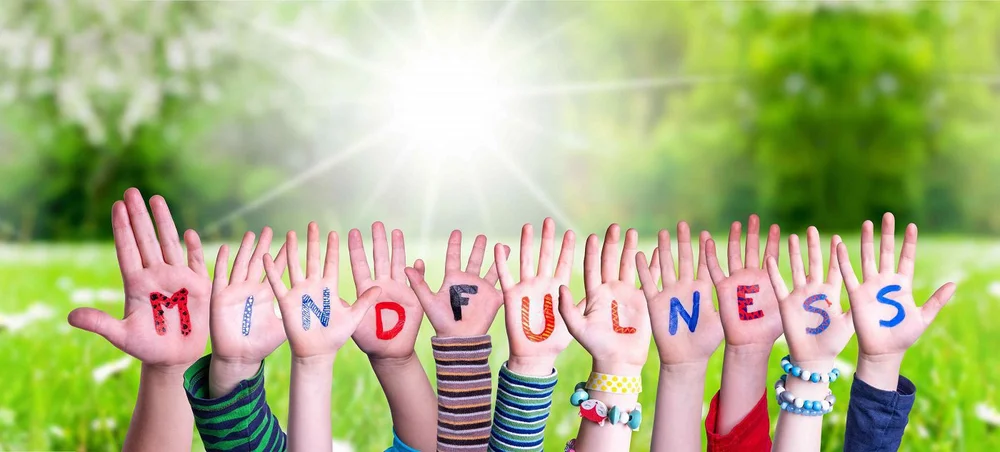Here’s What You Need to Know About Mindfulness for Kids
Now more than ever, young children and adolescents need tools to help them maintain calm and find emotional resilience.
In late October 2021, the American Academy of Pediatrics, the American Academy of Child and Adolescent Psychiatry, and the Children’s Hospital Association issued a joint statement declaring a national emergency in child and adolescent mental health.
What can parents do to teach their kids to be calm and resilient during these challenging times?
In one word: Mindfulness.
Yes, the popular relaxation and awareness practice among adults – which involves bringing a gentle, accepting attitude to the present moment through meditation, breathing, guided imagery, movement, and more – can help kids, too.
Mindfulness for Kids
A growing body of research on mindfulness for kids is showing remarkable results. Studies indicate that mindfulness practices in young people can help to reduce stress, anxious feelings, reactivity, and bad behavior.
Mindfulness for kids may also help them sleep better, feel better about themselves, and operate with greater calmness, self-awareness, and empathy.
Kids who practice mindfulness tend to do better with regulating their emotions and show improved memory, cognition, and executive function. Importantly, mindfulness can help young people to have greater attention, focus, and problem-solving function.
You can help your kids now by starting them with any of the following mindfulness activities.
6 of the Best Mindfulness Activities for Children and Teens
Children
Body poses provide a fantastic way to bring your child into mindfulness. Start by explaining to them that doing a fun and/or powerful poses can make them feel happy, strong, and brave.
Choose a safe place in your home or yard, and suggest they strike their favorite superhero pose. They could be Superman, standing with feet a little wider than hip-distance apart with fists clenched and arms out to the sky in either direction while they stretch as tall as they can.
Or maybe they want to be Wonder Woman, standing in the same manner but with hands or fists placed on their hips. Ask them what it feels like after a few rounds of trying different poses.
- Busy Mind/Calm Mind Jar
This is a fantastic mindfulness activity that illustrates how to find peace amidst overwhelming emotion. Get a mason jar and fill it nearly full of water. Then add a heaping spoonful of glitter glue or glue and dry glitter to the jar.
Put the lid on it and shake it until the glitter swirls and set it down. Then, say something like this:
“I want you to imagine that the glitter you see swirling are your thoughts if you’re mad or upset. Do you notice how they’re swirling around, and they make it really hard to see clearly? When you’re upset, and you have these swirling thoughts, it’s really hard to know what to do because your thinking isn’t clear.”
Put down the jar.
“Now look at what happens when you’re still for a minute or two. See how the glitter starts to settle to the bottom and the water becomes clearer? That’s the way your mind works, too. When you’re calm for a short while, swirling thoughts settle down and things become clear. Deep breaths during this calming process can help us settle when we feel a lot of emotions.”
This activity may help children to see how emotions can cloud their thinking, yet the mindfulness of watching the glitter in the jar calms the thoughts and promotes clear thinking.
- Spot the Animal
Go on a “spot the animal” walk with your child. This activity makes a daily walk an adventure, while enhancing the senses and providing focus, grounding them in the moment.
Explain to your kid that on this walk, the goal is to notice as many dogs, squirrels, birds, bugs, bunnies, and any other animals as they can. Anything that flies, runs, crawls, or swims is what they’re to spot and describe. They’ll need to focus all of their senses to find them.
Teens
- Write in a Journal
Writing in a journal can help a teen connect with their innermost feelings. Journal writing is wonderful for coping with low mood, anxious feelings, and stress while also providing an outlet for your teen to discover what’s important to him/her. With so many outward distractions, it’s a great exercise for them to be with their own thoughts and feelings.
- Start Cooking
Encourage your teen to bake or cook. Teach them to do it on their own. It’s highly meditative and requires focus on textures, flavors, and smells.
The sound of cutting vegetables or mixing batter can be calming. They’ll learn to appreciate every aspect of the food and will feel good about having created something rather than buying it.
- Drink Tea
Select some fine tea and make a cup with your teen to get them started. There’s a meditative quality to the tea steeping in a pot or mug. They can then sip it quietly and thoughtfully, perhaps staring out the window.
Tea involves all the senses and will bring them into the present. The soothing warmth of the mug will quiet and slow them down.
They should focus on the entire act of sipping out of the mug and how it feels. With each sip, they can allow worries of the day to melt away.
These are just a few tips for how to teach mindfulness for kids. Check mindfulness apps and videos online.
Of course, the best way to teach a child to be mindful is to embody the practice yourself. Be sure to keep up your own mindfulness practice!
At BrainMD, we’re dedicated to providing the highest purity nutrients to improve your physical health and overall well-being. For more information about our full list of brain healthy supplements, please visit us at BrainMD.
- Here Are Some of the Best Tension Release Exercises to Help You Feel Your Best! - April 17, 2024
- Foodscaping: How to Grow Healthy Foods In Your Own Garden! - April 12, 2024
- Eat Your Fruits and Veggies (Don’t Drink Them) - March 29, 2024




